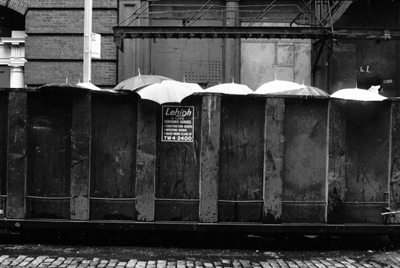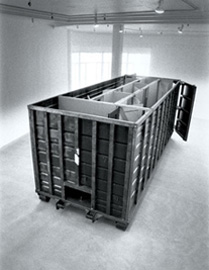You are in: Home page > Magazine Archive > Utopies réalisables et après.

Silvana Segapeli
Utopies réalisables et après.

Gordon Matta Clark, Open House (Also Called Drag-On & Dumpster), 1972. Industrial Container.
"(...)Les préoccupations relatives à lécologie focalisent désormais lattention sur la précarité des milieux de vie conduisant à explorer les entrelacs de lartefact avec les dynamiques tectoniques et biologiques plutôt quà poursuivre des volontés prométhéennes. Des postures de ruse sélaborent pour sallier à la nature en tant que puissance dynamique. Ce changement interpelle les fondations que larchitecture contribue à instaurer et les régénérations quelle peut susciter.
(Chris Younès)
The practice of redefining the architectural project in its eminently social role, beyond the internal unrest of the discipline, has assumed mounting importance for some generations, above all from the years when the energy emergency altered our system of perceiving the environment and the city. What capacity does architecture have to produce symbols that fit the current situation, that accord with the challenges of the sustainable, and what are the concrete vital tools through which the project reveals itself as a vehicle of new interpretative meanings of this changeable reality?
The current search for an aesthetic regime that takes into account the issue of sustainable development testifies to an awareness that points to a growing sense of responsibility among architects. The theme is certainly nothing new in the avenues of architectural culture; in Italy as far back as the late '50s Giancarlo De Carlo embodied the figure of an architect-educator, an edifying role of mediation between project and public/end-user. It is expedient to specify that, at the same time, also the idea of sustainable development has altered in parallel over the years, lending increasing weight to relational values and policies that arrange social relations within urban dynamics.
In this process, what elements exhort transformation, in the sense proposed by the new approaches to eco-conception, and what instead are the inerasable principles that form a permanent trace in our endeavours, as a sediment of cultural symptoms? If on the one hand Gregotti reminds us that the concept of stability was one of the founders of Western society, and that it has been brought to task in contemporary culture: We know that today there is (...) a profound diffidence towards notions such as foundation, essence, specificity, (1) on the other, new paradigms present themselves in the panorama of theories of an ecologist nature, and hark back to a different notion of transformation. According to Morin, metamorphosis, for example, would stand for the positive value of transformation, sublimating the radical nature of its change. (...) a richer idea than that of revolution, metamorphosis would guarantee a link with the past, replete with cultural legacies, an expression of ways of life consolidated over time, a collection of mutual symbolic values. (2) Ecologist thinking, of which Morin is an eminent exponent, has heavily influenced the culture of the contemporary project: the passage from a consumer culture to one of reuse and repair has been for several years a common field of study amongst architecture and the various disciplines that revolve around the sustainable development concept.
Rubbish is Beautiful
Some major work was carried out in the field of artistic practices long before the theories that lie in the Cradle to Cradle (3) appeared. The germs of an awareness of the necessity to inscribe project practices within a symbolic system autonomous from consumer codes dates back to the 60s, an era when avant-garde production of movements and collectives ‒ extremely prolific in terms of the elaboration of urban and social utopias ‒ imbued architecture with the allure of a collective art.
In that period, numerous artists began to work on the concept of rubbish', starting from Pop-Art, laden with contents critical of the consumer economy, leading to a rethinking of the symbolic values attributable to the new, to the original. Various examples might be mentioned, from Jean Dubuffets rehabilitation of discredited values to Kurt Schwitters Merzbau, from Vito Acconcis Garbage City (4) to Mierle Laderman Ukeles Manifesto for Maintenance.
J'ai toujours bien aimé, c'est une espèce de vice, ne mettre en uvre de matériaux que les plus communs, ceux auxquels on ne songe pas d'abord parce qu'ils sont trop vulgaires et proches et nous paraissent impropres à quoi que ce soit. J'aime à proclamer que mon art est une entreprise
de réhabilitation des valeurs décriées. C'est aussi que de ces éléments, qui d'être si répandus sont habituellement par cela même soustraits aux regards, je suis plus curieux que de tous autres. (5)
Particularly fertile, in this sense, was the period of the '70s, which saw the emergence of the atypical figure of Gordon Matta-Clark, an architect/artist from New York, engaged in the search for a different role for architecture in the structuring of socio-environmental bonds. From the Garbage Wall sculpture ‒ an assembly of everyday rubbish ‒ to the Fresh Kill cycle and Open House, one of the first installations realized with materials from demolition sites, his projects mark a determinant step towards a symbolic re-evaluation of rubbish'.
In the same period, again in the early '70s, Yona Friedman launched the international competition Rubbish is Beautiful, an event that first introduced the controversy throwaway versus repairable significantly linked to the notion of civic choice'. Friedman explains that in fact (...) le déchet nest déchet quen conséquence dune opération de sélection préconçue de composants utiles. Nous pourrions donc réduire, très simplement, la superproduction des déchets en transformant le mode dutilisation de certains objets, donc en changeant lopération-clé: la sélection. (6)
The series of Objets Déguisés, which was followed by the better known series Les Structures Irrégulières, constituted his personal response to the competition. Attention slipped from the formally determined object to its material nature and marked the departure point of a search for a necessary changement dattitude (7), which would long remain the guiding thread of all his work.
His posture solicited a revision of the internal logic of an economic system that perilously regulates all the relationships between man and matter, between individual and subject, between society and consumption. A system that must therefore be questioned through the construction of a different sense regime.
The theme is simple and complex at the same time, the objective lies in the necessity to reorganize society based on a redefinition of the relationship between individual and environment, creating a critical distance with respect to consumerism. Cultural factors play a crucial role in the assessment of rubbish', the possibility of conferring on waste a different statute is primarily linked to moral values and only secondly to technical and functional factors.
To the same period belong, on the scientific front, concepts of adaptability and reversibility, which insist on the building of a new value system, at the crossroads between the science of materials, biology and society: in 1973. the Canadian ecologist Crawford Stanley Holling formulated the concept of ecological resilience linked to complex systems of adaptation and self-adjustment, in terms of the capacity of a socio/eco-system to assume and manage a transformation.
At the same time, the prolific vein of the nouvelle écologie, already active in those years, was based on concepts belonging to biology and genetics, laying the accent on their cycles and biological rhythms.
The construction industry was the first to harvest the fruits. The concept of the lifecycle of materials which is now an indispensable tool in calculating the environmental impact of constructions, is linked genealogically to the studies of Richard Stein (8), which patently belong to this same era.
In effect, if the '70s brought the trace of clivage, the fracture line, between the uncontrolled industrial production of capitalist countries and an awareness of the environmental crisis, the era was certainly one of the most fertile as far as experimentation was concerned ‒ the building of new strategies, the structuring of different interpretative codes of ongoing phenomena ‒ and mapping it would be somewhat daunting in view of the breadth of the spectrum of action.
Last but not least, this might be one of the possible keys to steer the difficult passage of contemporary architectural culture through the environmental crisis. Within the scenario of a decline in capitalism, the idea that recovery, reuse and recycling are not concepts linked solely to the material challenges posed by sustainable culture, but extend to a maieutic dimension of the recovery of the legacy of forms of production and ways of life, finds comfort in various strands of research. (9)
1. Vittorio Gregotti, Contro la fine dell'architettura, Einaudi, Turin 2008, p. 22.
2. Cf. Edgar Morin, Eloge de la métamorphose, 2011. Internet site: lejour-et-lanuit.over-blog.com. "(
) L'idée de métamorphose, plus riche que l'idée de révolution, en garde la radicalité transformatrice, mais la lie à la conservation (de la vie, de l'héritage des cultures). (
)Tout commence, toujours, par une innovation, un nouveau message déviant, marginal, modeste, souvent invisible aux contemporains." (Edgar Morin)
3. Cf. William McDonough et Michael Braungart, Cradle to Cradle: Remaking the Way We Make Things, 2002.
4. Cf. Garbage City (Project for Hiriya Garbage Dump, Airya, Israel), 1999, The City that Rides a Garbage Dump (Bavel Garbage Tip, Breda, The Netherlands), 1999.
5. Dubuffet, L'homme du commun à l'ouvrage, "Prospectus et tous écrits suivants". Paris, Gallimard, collection Folio-Essais, 1991.
6. Yona Friedman, Utopies réalisables, Léclat, Paris 2008, (first edition 2000), p.99.
7. Ibid.
8.Richard Stein, Architecture and Energy, Anchor Press, 1977.
9. Cf. The research work by Néstor Garcia-Canclini (1991) who first identified the criterion of cultural reconversion in the processes of co-creation and readjustment.
Silvana Segapeli is an architect and PhD in urban and environmental
architectural projects and recovery. She teaches Landscape, Art and Design at the "École Nationale Supérieure d'Architecture de Saint-Etienne", and is a researcher at the GERPHAU - Laboratoire Philosophie Architecture Urbain, of the "École Nationale Supérieure d'Architecture Paris la Villette".

Gordon Matta-Clark, Open House (Also Called Drag-On & Dumpster), 1972. Wood.














